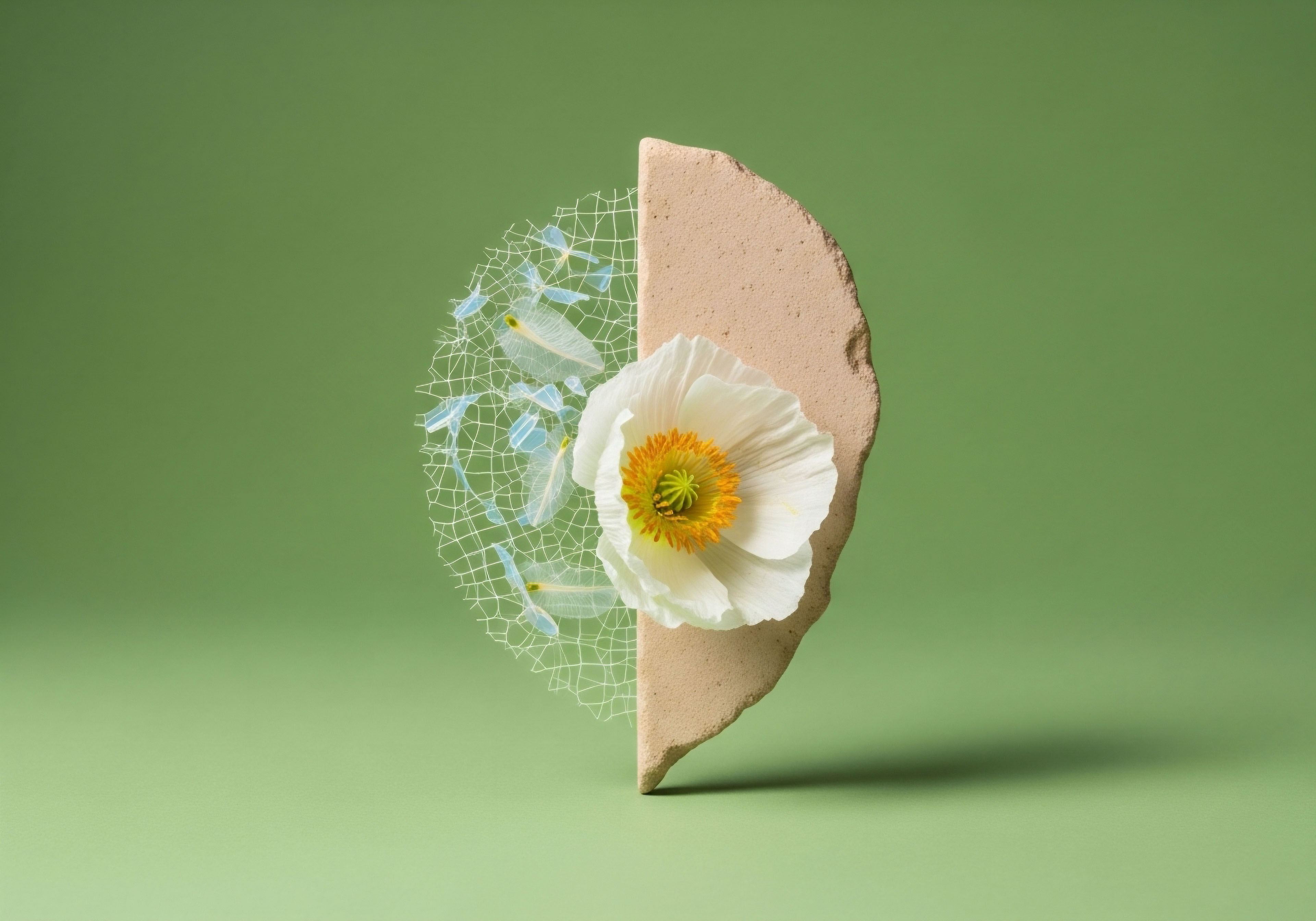

Fundamentals
When you ask about the negative beauty side effects of hormonal replacement therapy, you are truly asking about the body’s intricate process of recalibration. Your skin and hair are sensitive barometers for your internal hormonal environment. The changes you observe are direct communications from your biological systems as they adapt to a new biochemical reality.
These are not arbitrary penalties; they are predictable physiological responses. Understanding this process begins with recognizing the primary architects of your cutaneous health ∞ estrogen, progesterone, and testosterone. Each plays a distinct and powerful role in governing the life cycle of your skin cells and hair follicles.
Estrogen is a fundamental promoter of what we perceive as youthful skin. It supports hydration by enhancing the production of hyaluronic acid, a molecule that helps skin retain moisture. This hormone also stimulates collagen and elastin synthesis, the proteins that provide your skin with its structure and suppleness.
Consequently, when estrogen levels are optimized through hormonal support protocols, many individuals notice improved skin thickness and texture. The journey of hormonal recalibration, however, involves the entire endocrine system adjusting to these new levels, and this period of adaptation can manifest in visible ways.
The skin and hair serve as visible indicators of the body’s internal hormonal dialogue during therapeutic adjustments.
Testosterone, even in the small, precise amounts used in female protocols or the foundational doses in male therapy, has a potent effect. It is a primary driver of sebum production, the natural oil that moisturizes and protects the skin. An increase in testosterone can awaken dormant sebaceous glands, sometimes leading to an increase in oiliness and the potential for acne.
This is a common experience because the skin is responding directly to a new set of instructions. Similarly, this hormone influences hair follicles, capable of stimulating hair growth in some areas while also being implicated in the thinning of scalp hair for those with a genetic predisposition to androgenetic alopecia.
Progesterone adds another layer of complexity. Its role is to balance the effects of estrogen. Depending on the specific type of progestogen used in a therapeutic protocol, it can have varying effects. Some may gently complement estrogen’s actions, while others possess a slight androgenic quality that can contribute to changes like acne or shifts in hair texture.
The appearance of these effects is a sign that your body is diligently processing these new hormonal signals. The initial phase of any hormonal optimization protocol is one of dialogue and adjustment between the therapeutic inputs and your unique physiology. It is a period where close observation and communication with your clinical team are essential to guide the process toward a state of renewed equilibrium and vitality.


Intermediate
Advancing beyond foundational concepts requires a more granular examination of the mechanisms driving the dermatological changes seen during hormonal optimization. These aesthetic effects are direct consequences of how specific hormones interact with cellular receptors in the skin and its appendages. By understanding these pathways, we can appreciate how protocols are designed and adjusted to support an individual’s goals.
The three most common areas of concern are the emergence of acne, alterations in hair patterns, and changes to skin texture and pigmentation.

The Endocrinology of Hormonal Acne
The development of acne during hormonal therapy is a direct result of androgenic stimulation of the sebaceous glands. Here is the process:
- Hormonal Signal ∞ Testosterone, whether administered as part of male TRT or female testosterone therapy, circulates and reaches the skin. Certain synthetic progestins used in combined HRT can also carry androgenic properties that mimic testosterone’s effects at the cellular level.
- Glandular Activation ∞ The hormone binds to androgen receptors located on sebocytes, the cells that constitute the sebaceous glands. This binding action signals the gland to increase its production of sebum, the skin’s natural oil.
- Follicular Environment ∞ The resulting increase in sebum can alter the environment within the hair follicle, creating conditions conducive to the proliferation of the bacterium C. acnes and leading to inflammation.
- Clinical Manifestation ∞ The outcome is the appearance of comedones and inflammatory papules, commonly referred to as hormonal acne. This response is particularly common during the initial phase of therapy as the body’s sebaceous glands adapt to the new level of hormonal stimulation.
For men on TRT, protocols often include an aromatase inhibitor like Anastrozole. This medication blocks the conversion of testosterone to estrogen, a process called aromatization. While its primary purpose is to manage estrogen levels, altering the testosterone-to-estrogen ratio has systemic effects that also influence skin health. For women, the dose of testosterone is significantly lower, but the principle of sebaceous gland stimulation remains the same.

Navigating Hair Growth and Hair Loss
Hormones exert a profound and often dualistic influence on hair follicles, governing both growth and loss. Estrogen is generally supportive of scalp hair, helping to extend the anagen (growth) phase of the hair cycle. This is why some women notice fuller hair during periods of high estrogen.
Conversely, androgens have a more complex role. They are responsible for the development of coarser, darker terminal hair in androgen-sensitive areas like the face, chest, and limbs. This is the mechanism behind hirsutism, an occasional side effect of testosterone therapy.
Simultaneously, in individuals with a genetic predisposition for androgenetic alopecia (pattern hair loss), androgens can have the opposite effect on scalp follicles. Dihydrotestosterone (DHT), a potent metabolite of testosterone, can bind to scalp hair follicles, causing them to miniaturize and shorten their growth phase.
This leads to finer, shorter hairs and, eventually, a reduction in visible density. The progestin component of some HRT regimens can also possess androgenic activity, potentially accelerating this process in susceptible individuals. This highlights the importance of selecting the right hormonal components for each person’s unique genetic background.
Adjusting the type and dosage of hormones is a clinical strategy to align therapeutic outcomes with individual aesthetic goals.

How Do Hormonal Protocols Affect Skin Pigmentation?
Hormonal fluctuations are a well-documented factor in skin pigmentation. Estrogen stimulates melanocytes, the cells responsible for producing melanin, the pigment that gives skin its color. This is the underlying reason why some women develop melasma, often called the “mask of pregnancy,” during periods of significant hormonal shifts.
Introducing estrogen through HRT can sometimes trigger or exacerbate this condition in susceptible individuals. The effect is highly dependent on genetics and sun exposure, which works synergistically with hormonal stimulation to increase pigment production.
| Hormonal Agent | Common Positive Effects | Potential Negative Side Effects |
|---|---|---|
| Estrogen |
Increased skin hydration, improved elasticity, reduced wrinkles. |
Melasma (skin darkening), potential for fluid retention. |
| Testosterone |
Increased skin firmness, potential for improved skin healing. |
Acne, oily skin, hirsutism (unwanted hair growth), acceleration of androgenetic alopecia. |
| Micronized Progesterone |
Balances estrogen, generally low androgenic impact. |
Mild acne or mood changes in sensitive individuals. |
| Synthetic Progestins |
Provide endometrial protection. |
Varying degrees of androgenic activity, potentially causing acne and hair thinning. |


Academic
A sophisticated analysis of the dermatological side effects of hormonal therapies requires moving beyond a simple catalog of symptoms. It necessitates a deep exploration of the molecular cross-talk within the pilosebaceous unit ∞ the intricate structure comprising the hair follicle and its associated sebaceous gland.
The clinical outcomes of acne, hirsutism, and androgenetic alopecia are surface manifestations of complex intracellular signaling cascades, primarily governed by the local activity of androgens and the specific pharmacodynamics of the progestins utilized in combination therapies.

The Androgen Receptor as the Final Common Pathway
The androgen receptor (AR) is the critical mediator of the most common aesthetic side effects in hormonal recalibration. Both testosterone and certain synthetic progestins can act as ligands for this receptor. Upon binding, the ligand-receptor complex translocates to the nucleus of the cell ∞ be it a sebocyte or a dermal papilla cell in the hair follicle ∞ and functions as a transcription factor. This action directly alters gene expression, initiating the physiological changes observed clinically.
In the sebaceous gland, AR activation upregulates the genes involved in lipogenesis, leading to increased sebocyte proliferation and differentiation, and ultimately, greater sebum output. In the context of hair, the effect is site-specific. In androgen-sensitive areas like the beard region, AR activation promotes the transition of vellus (fine) hairs to terminal (coarse) hairs.
On the scalp of genetically predisposed individuals, sustained AR activation by DHT leads to the transcription of genes that promote follicular miniaturization, progressively shortening the anagen phase and resulting in alopecia.

Pharmacological Specificity of Progestins and Cutaneous Impact
The term ‘progesterone’ is often used colloquially, but in clinical practice, a distinction between bioidentical progesterone and synthetic progestins is paramount. Bioidentical micronized progesterone has a neutral or even anti-androgenic profile, as it can compete with testosterone for the enzyme 5-alpha reductase, which converts testosterone to the more potent DHT. Its impact on the skin and hair is therefore generally minimal or favorable.
Synthetic progestins, however, are a heterogeneous class of molecules engineered for stability and specific progestational effects. Their molecular structures can impart varying degrees of affinity for other steroid receptors, including the androgen receptor. This is the source of their “androgenic activity.”
- Low Androgenic Profile ∞ Progestins like drospirenone and dydrogesterone exhibit minimal to no binding to the androgen receptor. Some, like drospirenone, have anti-androgenic properties, making them less likely to cause acne or hair loss.
- Moderate Androgenic Profile ∞ Progestins such as norethindrone acetate or levonorgestrel possess a discernible affinity for the androgen receptor. Their use can be associated with a higher incidence of androgenic side effects in sensitive individuals.
- High Androgenic Profile ∞ Older generation progestins, less commonly used in modern HRT formulations, had more pronounced androgenic effects.
This pharmacological variance is a critical factor in personalizing therapy. A patient presenting with androgen-mediated side effects on a combined HRT regimen may benefit from a protocol change to a formulation containing a progestin with a more favorable, less androgenic profile.
The specific molecular structure of a synthetic progestin dictates its affinity for the androgen receptor and its potential to induce cutaneous side effects.

Can the HPG Axis Adapt to Minimize Side Effects?
The introduction of exogenous hormones sends feedback to the Hypothalamic-Pituitary-Gonadal (HPG) axis, suppressing endogenous hormone production. For instance, in male TRT, administration of testosterone suppresses the release of Luteinizing Hormone (LH) and Follicle-Stimulating Hormone (FSH). Protocols often include agents like Gonadorelin to maintain testicular function and mitigate complete shutdown of this axis.
This systemic recalibration means the body is operating within a new hormonal state. While the initial dermatological effects can be pronounced, some degree of adaptation occurs. Sebaceous glands may normalize their output over time, and the body establishes a new homeostatic baseline. However, genetically determined sensitivities, such as the predisposition to pattern hair loss, are permanent biological traits that hormonal therapy will interact with, rather than eliminate.
| Agent | Classification | Relative Androgenic Activity | Clinical Implications for Skin and Hair |
|---|---|---|---|
| Micronized Progesterone |
Bioidentical |
Neutral to Anti-Androgenic |
Lowest risk of acne or hair loss; may be protective. |
| Drospirenone |
Synthetic Progestin (Spironolactone analogue) |
Anti-Androgenic |
Beneficial for acne; often used in oral contraceptives for skin benefits. |
| Dydrogesterone |
Synthetic Progestin (Retroprogesterone) |
Very Low / Negligible |
Considered neutral in its effect on skin and hair. |
| Norethindrone Acetate |
Synthetic Progestin (19-nortestosterone derivative) |
Low to Moderate |
May cause or worsen acne and hair thinning in sensitive individuals. |
| Levonorgestrel |
Synthetic Progestin (19-nortestosterone derivative) |
Moderate |
Higher potential for androgenic side effects compared to newer progestins. |

References
- Ganceviciene, R. et al. “Skin anti-aging strategies.” Dermato-endocrinology, vol. 4, no. 3, 2012, pp. 308-19.
- Stevenson, S. and J. Thornton. “Effect of estrogens on skin aging.” American Journal of Clinical Dermatology, vol. 8, no. 4, 2007, pp. 219-30.
- “Side effects of hormone replacement therapy (HRT).” National Health Service (NHS), 2023.
- Veraitch, Ophelia. “Hormone replacement therapy (HRT) and its effects on skin and hair.” Top Doctors, 2025.
- Lephart, E. D. “A review of the role of estrogen in dermal aging and facial attractiveness in women.” Journal of Cosmetic Dermatology, vol. 17, no. 3, 2018, pp. 282-88.

Reflection
Having explored the intricate biological pathways that connect hormonal optimization to your skin and hair, the journey forward becomes one of personalized partnership. The information presented here is the map, showing the terrain of your body’s potential responses. It is the beginning of a conversation.
The true work lies in observing your unique reactions and communicating them to your clinical team. This process allows for the precise, iterative adjustments that define sophisticated medical care. Your body is a dynamic system, constantly seeking equilibrium. The goal is to work with that system, providing the specific inputs it needs to function with renewed vitality.
Consider this knowledge not as a list of warnings, but as the foundational understanding required to navigate your path to wellness with confidence and agency.



